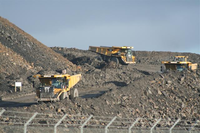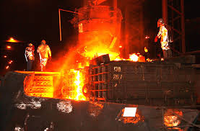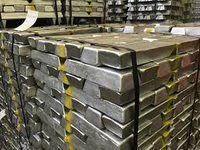Extraction of Metals
Contents
Key Stage 3
Meaning
Extraction of Metals is how we get usable metal from ore found in the ground.
About Extraction of Metals
There are 3 main ways extraction of metals takes place:
- None - Elements below Hydrogen are found Native which means the metal element can be found not as part of a compound.
- Smelting - Elements above Hydrogen but below Carbon are found in minerals, which are metal compounds so they need to be extracted by using Carbon to displace the metal from the compound.
- Electrolysis - Elements above Carbon are found in minerals but they cannot be extracted with Carbon because Carbon is less reactive than those metals so we use electrolysis to extract them.
| The ores are mined from the ground using explosives and heavy machinery. | The ores are transported to metal refineries by trucks, trains and boats. The metal refineries can be thousands of miles away. | The material is purified to remove unwanted pieces of rock. If the metal is native it is put in a furnace to melt. If the metal is in a compound it is either put in a furnace with Carbon to displace it or it is placed in an electrolysis cell to be extracted with electricity. | The metal is then molded into ingots before being transported again to where they are needed. |
Environmental Concerns
- All stages of the extraction process can cause damage to the environment and concerns are raised about the local impact and global impact of extraction.
Local Concerns
- A large area of land is destroyed to make space for a quarry. This can be habitats for local organisms.
- Local people complain of increased traffic.
- Explosives are often used in mining which can disturb local people and wildlife.
- People who live near metal refineries can be affected by the pollution given off by the refinery.
Global Concerns
- Machines used to mine produce Carbon Dioxide which contribute to Global Warming.
- Transporting ore produces Carbon Dioxide which contribute to Global Warming.
- Metal refineries produce Carbon Dioxide as well as other pollution including Sulphur Dioxide and Nitrous Oxides which lead to Acid Rain.
Key Stage 4
Meaning
Extraction of Metals is the process of removing a metal from a mineral.
About the Extraction of Metals
There are 4 methods for extracting metals from minerals:
- Electrolysis - Which can be done for all metals, but usually only those more reactive than Carbon on the reactivity series.
- Smelting - Which can be done for metals less reactive than Carbon on the reactivity series.
- Bioleaching - Which can be done for any metals and is usually used on ores with a low mineral content.
- Phytomining - Which can be done for any metals and is usually used on ores with a low mineral content.
- The method chosen to extract a metal depends on the energy needed, the cost and the time taken.
- Smelting requires very high temperatures to melt the minerals from the ore which is expensive.
- Electrolysis can be done in solution with water at low temperatures if the mineral is soluble and the metal does not react strongly with water. This is relatively cheap as only the energy needed for the electrolysis is needed.
- Electrolysis must sometimes be done at high temperatures to melt the mineral if it is insoluble or the metal reacts with water. This is expensive because it needs energy to heat the mineral and then more energy for electrolysis.
- Bioleaching uses bacteria to extract minerals from ore which happens at room temperature and is then followed by Electrolysis of minerals in solution. This is relatively cheap but it takes the bacteria a long time to remove the minerals which means it is often not worth the time it takes.
- Phytomining uses plants to extract minerals from ore which happens at room temperature and is then followed by Electrolysis of minerals in solution. This is relatively cheap but it takes the plants a long time to remove the minerals which means it is often not worth the time it takes.
References
AQA
Edexcel
- Extraction of metals, page 232, GCSE Combined Science, Pearson Edexcel
- Extraction of metals, pages 117, 118, GCSE Combined Science; The Revision Guide, CGP, Edexcel
- Extraction of metals, pages 155-160, GCSE Chemistry, CGP, Edexcel
- Extraction of metals, pages 55, 56, GCSE Chemistry; The Revision Guide, CGP, Edexcel
- Extraction of metals; bioleaching, page 56, GCSE Chemistry; The Revision Guide, CGP, Edexcel
- Extraction of metals; electrolysis, page 56, GCSE Chemistry; The Revision Guide, CGP, Edexcel
- Extraction of metals; phytoextraction, page 56, GCSE Chemistry; The Revision Guide, CGP, Edexcel
- Extraction of metals; reduction with carbon, page 55, GCSE Chemistry; The Revision Guide, CGP, Edexcel
- Extractions of metals, page 88, GCSE Chemistry, Pearson, Edexcel
OCR
- Metal extraction, pages 206-213, Gateway GCSE Chemistry, Oxford, OCR
- Metal extraction; aluminium, pages 210-211, Gateway GCSE Chemistry, Oxford, OCR
- Metal extraction; biological, pages 212-213, Gateway GCSE Chemistry, Oxford, OCR
- Metal extraction; copper, pages 207, 227, Gateway GCSE Chemistry, Oxford, OCR
- Metal extraction; electrolysis, pages 206, 210-211, Gateway GCSE Chemistry, Oxford, OCR
- Metal extraction; iron, pages 208-209, Gateway GCSE Chemistry, Oxford, OCR
- Metal extraction; waste rock, page 227, Gateway GCSE Chemistry, Oxford, OCR
- Metal extraction; with carbon, pages 206-209, Gateway GCSE Chemistry, Oxford, OCR



